Table of Contents
Flowers have been nature’s most enchanting creations, captivating humanity with their vibrant colors, delicate petals, and captivating fragrances. With over 400,000 species of flowering plants globally, flowers not only beautify our world but also play vital ecological and cultural roles. From symbolizing emotions to supporting pollinators and providing medicinal benefits, their contributions are unparalleled.
In this comprehensive guide, we delve into over 100 unique flower names, exploring their scientific backgrounds, defining features, and multifaceted significance. Whether you are a gardening enthusiast, a student of botany, or someone who simply admires the beauty of blooms, this article provides an insightful journey through the fascinating world of flowers. Each entry highlights their ecological roles, aesthetic values, and the rich cultural meanings that have made them enduring symbols of human expression.
🌼 Alphabetical (A-Z) Flower Names List
Flower names start with “A”
1. Aster (Symphyotrichum spp.)
- Description: Small star-shaped flowers in shades of purple, blue, pink, and white.
- Features: Blooms in late summer and fall.
- Uses: Popular in bouquets and as ornamental plants.
- Aesthetic Value: Adds color to gardens in late seasons.
- Ecological Role: Attracts pollinators like bees and butterflies.
- Cultural Significance: Symbolizes love and patience.

2. Allium (Allium giganteum)
- Description: Known for its globe-like clusters of small purple flowers.
- Features: Belongs to the onion family; grows tall.
- Uses: Ornamental borders and garden focal points.
- Aesthetic Value: Unique geometric flowerheads.
- Ecological Role: Supports bees and other pollinators.
- Cultural Significance: Represents unity and good fortune.

3. Azalea (Rhododendron spp.)
- Description: Vibrant trumpet-shaped flowers in various colors.
- Features: Prefers acidic soil and partial shade.
- Uses: Landscaping in shaded areas.
- Aesthetic Value: Dramatic spring blooms.
- Ecological Role: Provides nectar for pollinators.
- Cultural Significance: Associated with femininity and passion in many cultures.

4. Amaryllis (Hippeastrum)
- Description: Large, trumpet-shaped blooms in shades of red, white, and pink.
- Feature: Typically grown indoors during winter.
- Uses: Holiday décor and ornamental purposes.
- Aesthetic Value: Adds a festive touch during the colder months.
- Ecological Role: Often cultivated as indoor plants with minimal ecological impact.
- Cultural Significance: Represents pride and radiant beauty.

5. Anemone
- Description: Known as windflowers, Anemones belong to the Ranunculaceae family and are cherished for their delicate, poppy-like flowers.
- Varieties: Available in shades of white, pink, purple, red, and blue.
- Habitat: Native to temperate zones and thrive in well-drained, rich soils.
- Feature: They bloom in spring or autumn, depending on the species.
- Cultural Significance: Associated with anticipation and protection in mythology.
- Gardening Use: Perfect for borders, rock gardens, and woodland settings
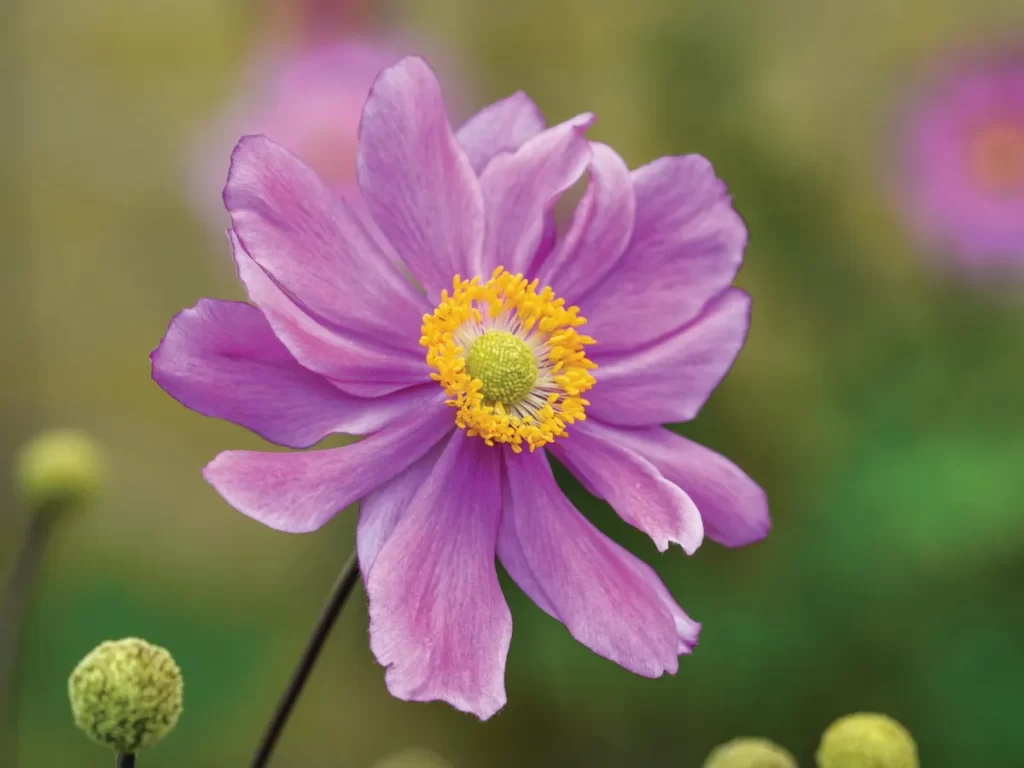
6. Angelonia
- Description: Often referred to as “Summer Snapdragon,” Angelonia is an easy-care annual that produces tall spires of colorful blooms.
- Varieties: Comes in shades of purple, pink, and white.
- Feature: Flowers are fragrant and bloom throughout the summer, requiring minimal care.
- Gardening Use: Ideal for containers, garden beds, and borders.
- Ecological Role: Attracts pollinators like bees. Its flowers are uniquely adapted for pollination

Flower names start with “B”
7. Bluebell (Hyacinthoides non-scripta)
- Description: Bell-shaped blue flowers often carpeting woodlands.
- Features: Prefers shady, moist environments.
- Uses: Adds charm to woodland gardens.
- Aesthetic Value: Evokes a dreamy, fairytale-like atmosphere.
- Ecological Role: Provides nectar for bees in spring.
- Cultural Significance: Symbol of humility and everlasting love.

8. Buttercup (Ranunculus spp.)
- Description: Glossy yellow flowers with cup-shaped petals.
- Features: Thrives in damp meadows and fields.
- Uses: Wildflower gardens and medicinal purposes.
- Aesthetic Value: Brightens wild landscapes.
- Ecological Role: Source of nectar for insects.
- Cultural Significance: Represents joy and childhood memories.

9. Begonia (Begonia)
- Description: A versatile flower with waxy petals, often found in bright pink, red, or white.
- Feature: Thrives in shady areas, making it a favorite for indoor gardening.
- Uses: Ornamental potted plants or bedding displays.
- Aesthetic Value: Adds a tropical touch to gardens and patios.
- Ecological Role: Improves air quality indoors.
- Cultural Significance: Represents gratitude and individuality.

10. Bleeding Heart (Lamprocapnos spectabilis)
- Description: Heart-shaped pink and white flowers that dangle along arching stems.
- Feature: Thrives in shady woodland gardens.
- Uses: Ornamental plants for shaded areas.
- Aesthetic Value: Adds a romantic touch to landscapes.
- Ecological Role: Attracts pollinators in spring.
- Cultural Significance: Represents undying love and compassion.

11. Baby’s Breath (Gypsophila)
- Description: A delicate perennial producing clusters of tiny, white or pink flowers that appear like fluffy clouds.
- Uses: Commonly used in floral arrangements and bouquets for its airy texture.
- Growth Requirements: Thrives in full sun and dry soil, blooming from April to August.
- Features: Known for its longevity in gardens and floral displays.

12. Bird of Paradise (Strelitzia)
- Description: Known for its striking resemblance to a tropical bird in flight, this flower features vibrant orange and blue hues.
- Uses: A symbol of paradise and freedom, often used in exotic gardens and floral arrangements.
- Growth Requirements: Prefers warm climates, partial to full sunlight, and well-drained soil.
- Features: Flowers year-round in the right conditions, adding a tropical flair to landscapes.

13. Balloon Flower (Platycodon grandiflorus)
- Description: Named for its unique balloon-shaped buds that open into star-shaped, purple, blue, or white flowers.
- Uses: Popular in perennial borders and rock gardens.
- Growth Requirements: Requires well-drained soil and moderate sunlight.
- Features: Easy to care for and blooms during the summer.

15. Bee Balm (Monarda)
- Description: A fragrant flower with tubular blooms in shades of red, pink, purple, or white, known for attracting pollinators.
- Uses: A favorite in pollinator gardens and herbal remedies (leaves can be used for tea).
- Growth Requirements: Thrives in full sun and moist, well-drained soil.
- Features: Blooms in mid to late summer and is deer-resistant.
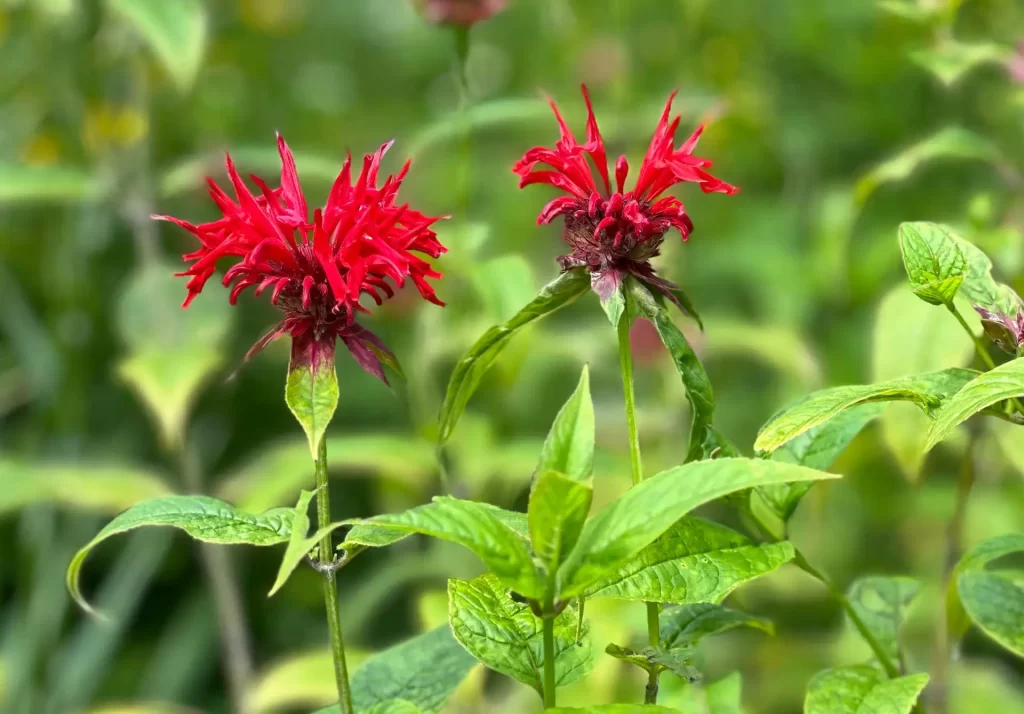
Flower names start with “C”
16. Camellia(Camellia japonica)
- Description: Large, rose-like blooms in red, pink, and white.
- Features: Evergreen shrub with glossy leaves.
- Uses: Ornamental gardens and tea production.
- Aesthetic Value: Symbolizes elegance and beauty.
- Ecological Role: Offers food for bees in early spring.
- Cultural Significance: Represents admiration and perfection in East Asian traditions.

17. Chrysanthemum(Chrysanthemum morifolium)
- Description: Wide range of blooms, from daisy-like to intricate pompoms.
- Features: Late-season bloomer with vibrant colors.
- Uses: Floral arrangements and medicinal purposes.
- Aesthetic Value: Adds fall color to gardens.
- Ecological Role: Attracts bees and butterflies.
- Cultural Significance: Symbol of longevity in Chinese culture; mourning in Europe.

18. Carnation (Dianthus caryophyllus)
- Description: Known for their ruffled petals and sweet fragrance, carnations come in a variety of colors.
- Uses: Popular in bouquets, floral arrangements, and as boutonnieres.
- Growth Requirements: Prefer full sun and well-drained, fertile soil.
- Features: Symbolize love, fascination, and distinction.

19. Canna Lily (Canna)
- Description: Tropical plants with large, bold leaves and vibrant flowers in shades of red, orange, yellow, and pink.
- Uses: Decorative in gardens and landscapes for a lush, tropical feel.
- Growth Requirements: Thrive in full sun and moist, well-drained soil.
- Features: Blooms from late spring to early fall.

20. Canterbury Bells (Campanula medium)
- Description: Bell-shaped flowers in shades of blue, purple, pink, or white.
- Uses: Ideal for cottage gardens and borders.
- Growth Requirements: Need partial to full sun and well-drained soil.
- Features: Biennial plants that bloom in the second year.

21. Clematis
- Description: A climbing vine with large, showy flowers in various colors, including purple, pink, and white.
- Uses: Often used on trellises, fences, and walls for vertical interest.
- Growth Requirements: Requires full to partial sun and moist, well-drained soil.
- Features: Blooms from spring to autumn, depending on the variety.

22. Coneflower (Echinacea)
- Description: Daisy-like flowers with raised cone-shaped centers, typically in pink, purple, or white.
- Uses: Attracts pollinators and is used in herbal remedies.
- Growth Requirements: Prefers full sun and well-drained soil.
- Features: Drought-tolerant and blooms from summer to early fall.

23. Cockscomb (Celosia cristata)
- Description: Unique, velvety blooms resembling a rooster’s comb, available in vibrant red, orange, yellow, and pink.
- Uses: Adds texture to gardens and floral arrangements.
- Growth Requirements: Thrives in full sun and rich, moist soil.
- Features: Blooms in late summer and fall.
24. Coral Bells (Heuchera)
- Description: Known for their striking foliage in shades of green, red, purple, and silver, with small bell-shaped flowers.
- Uses: Ideal for borders and shade gardens.
- Growth Requirements: Prefer partial shade and well-drained soil.
- Features: Evergreen in mild climates and blooms in late spring.
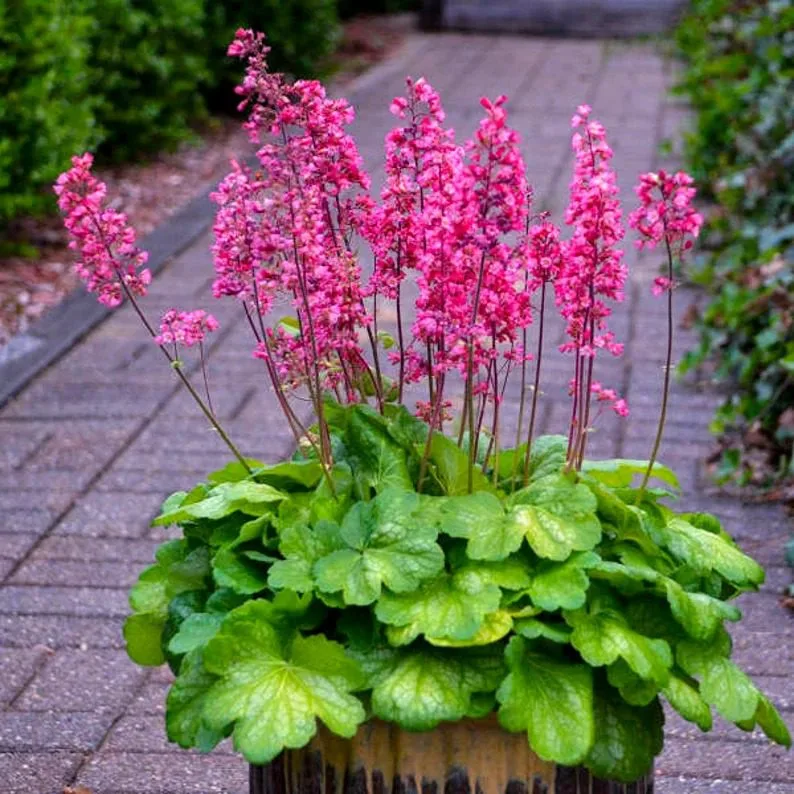
25. Crocus
- Description: Small, cup-shaped flowers that bloom in early spring or autumn, in shades of purple, yellow, and white.
- Uses: Popular in rock gardens and lawns.
- Growth Requirements: Requires full sun to partial shade and well-drained soil.
- Features: One of the first flowers to bloom after winter.

26. Cuphea
- Description: Shrubby plants with small, tubular flowers resembling tiny cigars, often in red, orange, or purple.
- Uses: Attractive to hummingbirds and used in container gardens.
- Growth Requirements: Thrives in full sun and well-drained soil.
- Features: Blooms profusely throughout the growing season.

Flower names start with “D”
27. Dahlia(Dahlia spp.)
- Description: Large, intricate blooms in a variety of colors.
- Features: Thrives in well-drained soil with full sun.
- Uses: Decorative cut flowers and garden showpieces.
- Aesthetic Value: Adds drama and richness to landscapes.
- Ecological Role: Provides nectar for pollinators.
- Cultural Significance: Represents creativity and inner strength.

28. Daffodil(Narcissus spp.)
- Description: Trumpet-shaped flowers in yellow, white, or orange.
- Features: Blooms in early spring.
- Uses: Borders and naturalized gardens.
- Aesthetic Value: Sign of spring’s arrival.
- Ecological Role: Early nectar source for bees.
- Cultural Significance: Symbolizes renewal and hope.

29. Daisy
- Description: Daisies are cheerful, simple flowers with white petals and a yellow center, symbolizing purity and innocence. They belong to the Asteraceae family.
- Uses: Common in gardens, floral arrangements, and as ornamental plants.
- Growth Requirements: Thrive in full sun with well-drained soil and bloom in spring and summer.
- Features: Low-maintenance and attract pollinators like bees and butterflies.

30. Delphinium
- Description: Tall, spiked flowers with a range of vibrant colors including blue, purple, white, and pink. They are members of the Ranunculaceae family.
- Uses: Frequently used in garden borders and floral arrangements for their vertical elegance.
- Growth Requirements: Prefer full sun and moist, well-drained soil.
- Features: Bloom in late spring to summer and are toxic if ingested.

31. Dogwood Flower
- Description: Flowers of the dogwood tree, featuring four petal-like bracts in shades of white or pink surrounding a central cluster of tiny flowers.
- Uses: Symbolic of rebirth and widely planted as ornamental trees.
- Growth Requirements: Thrive in partial shade to full sun with rich, well-drained soil.
- Features: Bloom in spring and are followed by bright red berries that attract birds.

32. Dutch Iris (Iris hollandica)
- Description: Known for their elegant, colorful blooms in shades of blue, yellow, and white. These perennials belong to the genus Iris.
- Uses: Popular in cut flower arrangements and garden displays.
- Growth Requirements: Require full sun and well-drained soil; bloom in late spring to early summer.
- Features: Their structure resembles the fleur-de-lis symbol

Flower names start with “E”
33. Edelweiss(Leontopodium nivale)
- Description: White, woolly star-shaped flowers found in alpine regions.
- Features: Thrives in rocky, mountainous areas.
- Uses: Symbolic in floral arrangements and alpine gardens.
- Aesthetic Value: Unique charm associated with high altitudes.
- Ecological Role: Resistant to harsh climates, contributing to alpine biodiversity.
- Cultural Significance: Symbol of bravery and eternal love.

34. Echinacea
- Description: Commonly known as coneflowers, Echinacea is a perennial flower with daisy-like blooms and a prominent cone-shaped center. Colors include pink, purple, yellow, and white.
- Uses: Known for its medicinal properties, particularly in boosting the immune system. It’s also widely used in garden landscapes.
- Growth Requirements: Thrives in full sun with well-drained soil. It is drought-tolerant and attracts pollinators like bees and butterflies.
- Features: Blooms in summer and adds vibrant color to any garden.
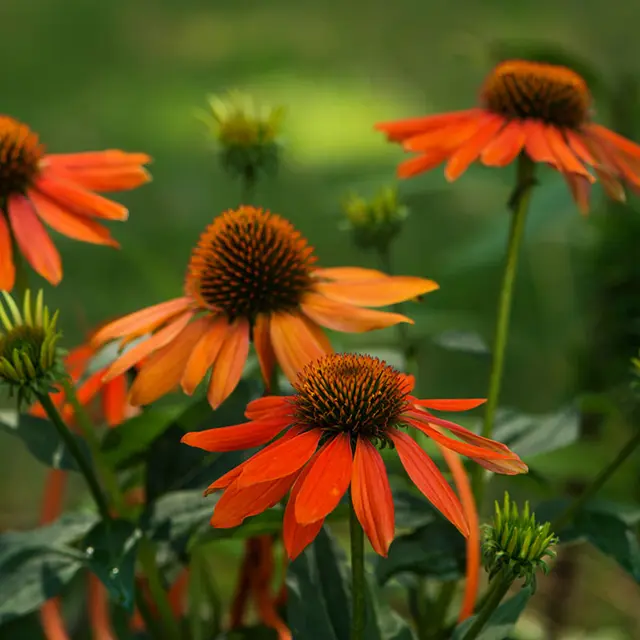
35. Everlasting Flower
- Description: These are hardy flowers that maintain their shape and color even after drying. Common varieties include Helichrysum and Strawflowers.
- Uses: Popular in dried floral arrangements, wreaths, and crafts due to their long-lasting nature.
- Growth Requirements: Prefer full sun and sandy, well-draining soil.
- Features: They are low-maintenance and ideal for decorative purposes.

36. Evening Primrose
- Description: Evening Primrose (Oenothera) is a fragrant flowering plant with bright yellow blooms that open in the evening.
- Uses: Commonly used in prairie gardens and for medicinal purposes, particularly evening primrose oil.
- Growth Requirements: Grows well in full sun with well-drained soil and tolerates various conditions, including rocky or sandy soil.
- Features: Blooms in late spring and summer, adding beauty to wildflower gardens.

Flower names start with “F”
37. Freesia(Freesia spp.)
- Description: Bell-shaped, fragrant flowers in bright colors.
- Features: Often used for its sweet scent.
- Uses: Perfumes, bouquets, and home gardens.
- Aesthetic Value: Adds elegance and charm.
- Ecological Role: Attracts pollinators like bees.
- Cultural Significance: Represents friendship and innocence.

38. Forget-Me-Not
- Description: Forget-me-nots, or Myosotis, are delicate, five-petaled flowers that typically feature a bright blue color with a yellow center, although they can also appear in pink or white.
- Symbolism: Known for their associations with true love, respect, and remembrance, they are popular in bridal bouquets and symbolize enduring bonds.
- Growth Requirements: These flowers thrive in well-drained soil with partial to full shade. They bloom from spring to early summer and are ideal for woodland and cottage gardens.

39. Foxglove
- Description: Digitalis purpurea is a striking biennial or short-lived perennial known for its tall spikes covered in tubular flowers, usually purple, but also available in white, pink, and yellow.
- Uses: Widely cultivated for ornamental purposes, its tall, bell-like flowers add drama to garden beds and are attractive to pollinators.
- Caution: All parts of the plant are toxic if ingested, so it should be kept out of reach of children and pets.
- Growth Requirements: Prefers full sun to partial shade and moist, well-drained soil.

40. Fuchsia
- Description: Fuchsia plants are known for their unique, teardrop-shaped flowers that often appear in shades of pink, red, purple, and white. The flowers have a distinctive, drooping form and are often seen on long, arching stems.
- Uses: Popular in hanging baskets and containers, they thrive in shaded or semi-shaded garden spots and are often used as accent plants or for adding color to patios.
- Growth Requirements: Prefer moist, well-drained soil and thrive in partial to full shade. They are sensitive to frost, so they are usually grown as annuals in colder climates.

Flower names start with “G”
41. Geranium(Pelargonium spp.)
- Description: Rounded clusters of small flowers in various colors.
- Features: Easy to grow, drought-resistant.
- Uses: Ground cover, hanging baskets, and containers.
- Aesthetic Value: Brightens patios and balconies.
- Ecological Role: Helps deter pests in companion planting.
- Cultural Significance: Symbol of comfort and healing.

42. Gardenia
- Description: Gardenias are beloved for their creamy white, fragrant blooms that emit a rich, sweet scent. The flowers are typically round, with waxy petals and a distinctive fragrance.
- Uses: Popular in gardens, especially for their aromatic appeal, gardenias also make stunning additions to bouquets.
- Growth Requirements: They need well-draining, acidic soil and prefer full sun to partial shade. They thrive in warm climates and require consistent watering to flourish.

43. Gazania
- Description: Also known as African daisies or treasure flowers, gazanias are vibrant, warm-weather perennials with daisy-like blooms in yellow, orange, and red.
- Uses: Often used as ground cover or in containers due to their bright colors and resistance to drought.
- Growth Requirements: Gazanias thrive in full sun and well-drained soil, and they are known for their ability to withstand dry conditions.
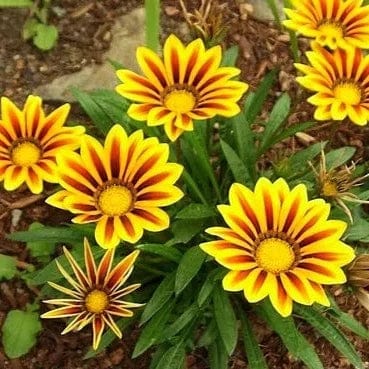
44. Gerbera Daisy
- Description: Gerbera daisies are known for their bold, colorful blooms that resemble sunflowers and come in hues like pink, red, yellow, and orange.
- Uses: Commonly used in floral arrangements and as potted plants, they are popular for their cheerful look.
- Growth Requirements: These plants prefer full sun and rich, well-draining soil. Regular watering is essential, especially during their growing season.

45. Gladiolus
- Description: Gladiolus flowers grow on tall spikes with tubular blooms that open from the bottom up. They are available in many colors, from white and pink to vibrant reds and purples.
- Uses: Often used in floral displays for their dramatic height and striking appearance.
- Growth Requirements: They require full sun and well-drained soil. Planting gladiolus corms in spring ensures summer blooms.

46. Ginger Flower
- Description: The ginger flower is part of the Zingiberaceae family, known for its intricate, cone-shaped blooms. The flowers can be white, yellow, or red and often have a tropical look.
- Uses: Used in tropical landscaping, these flowers can also be grown for their medicinal properties.
- Growth Requirements: They prefer warm, humid climates and need rich, well-drained soil with partial shade to thrive.

47. Goldenrod
- Description: Goldenrod is a tall, herbaceous plant with clusters of bright yellow flowers. It is known for attracting pollinators like bees and butterflies.
- Uses: Commonly used in wildflower gardens for its vibrant color and ecological benefits.
- Growth Requirements: Goldenrod grows well in full sun and well-drained soil and is tolerant of dry conditions.
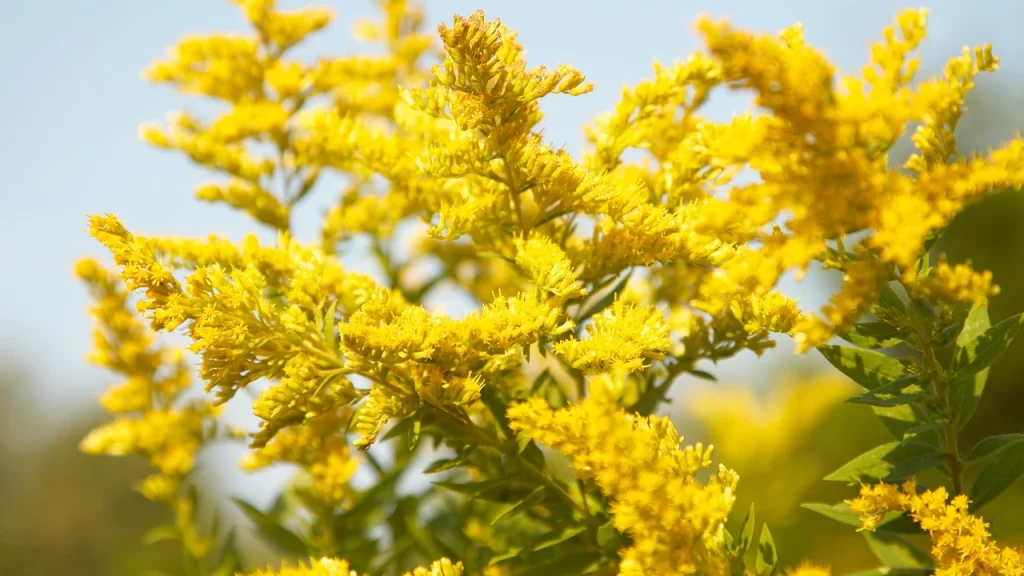
Flower names start with “H”
48. Hibiscus(Hibiscus rosa-sinensis)
- Description: Large, showy flowers in vibrant shades.
- Features: Thrives in warm climates.
- Uses: Herbal teas, landscaping, and hair care products.
- Aesthetic Value: Exotic tropical charm.
- Ecological Role: Supports pollinators like bees and hummingbirds.
- Cultural Significance: Represents delicate beauty and femininity.

49. Honeysuckle (Lonicera)
- Description: A fragrant climber with tubular flowers in shades of white, pink, or yellow.
- Feature: Known for its intoxicating scent, particularly in the evenings.
- Uses: Attracts bees, hummingbirds, and butterflies; used in traditional medicine.
- Aesthetic Value: Often used in trellises and arbors for decorative purposes.
- Ecological Role: Supports pollinators and provides shelter for small birds.
- Cultural Significance: Represents devoted love and bonds in various cultures.

50. Hellebore
- Description: Hellebores, also known as “Lenten roses,” are perennial plants known for their elegant, nodding flowers that bloom in late winter to early spring. Their blooms come in shades of white, pink, purple, and even green.
- Uses: Valued in gardens for their early bloom and ability to provide color when few other plants are in flower. They also attract early pollinators.
- Growth Requirements: Prefer partial shade and rich, moist, well-draining soil. They are hardy plants, suitable for USDA zones 3–8, and are relatively low-maintenance.

51. Hyacinth
- Description: Hyacinths are bulbous spring perennials known for their dense clusters of small, fragrant flowers that grow on a tall stem. They come in colors like blue, purple, pink, white, and red.
- Uses: Popular in gardens and for indoor forcing during winter months to brighten spaces with their fragrance and color.
- Growth Requirements: Hyacinths need full sun to partial shade and well-draining soil. They should be planted in the fall for spring blooms and prefer cooler climates.

52. Hydrangea
- Description: Hydrangeas are known for their large, showy flower clusters that range in color from blue and pink to white and purple. The color of their blooms can change based on soil pH.
- Uses: Often used as decorative shrubs in gardens and landscapes for their dramatic, colorful blooms.
- Growth Requirements: Hydrangeas prefer partial to full sun, depending on the variety, and thrive in well-drained, rich soil. Some species, like Hydrangea macrophylla, are particularly sensitive to soil acidity, affecting the flower color.

Flower names start with “I”
53. Iris(Iris germanica)
- Description: Graceful, sword-like leaves with intricate, three-petal blooms in vibrant colors such as purple, yellow, and blue.
- Features: Grows well in sunny gardens and tolerates wet soil conditions.
- Uses: Ornamental gardens, floral arrangements, and perfumes.
- Aesthetic Value: A classic flower that adds elegance to garden borders and vases.
- Ecological Role: Attracts bees, hummingbirds, and butterflies, playing a vital role in pollination.
- Cultural Significance: Symbolizes royalty, wisdom, and valor in many cultures; the fleur-de-lis is modeled after the iris.

54. Indian Paintbrush(Castilleja spp.)
- Description: Distinctive clusters of bright red or orange bracts that resemble a painter’s brush.
- Features: Grows in meadows and prairies; thrives in well-drained soil.
- Uses: Naturalized wildflower areas and native plant gardens.
- Aesthetic Value: Adds vibrant colors to landscapes and wild gardens.
- Ecological Role: Supports native pollinators, especially bees.
- Cultural Significance: Revered by Native American tribes as a symbol of creativity and nature’s artistry.

55. Indian Blanket Flower (Gaillardia pulchella)
- Description: The Indian Blanket Flower, also known as Gaillardia pulchella, is a bright and showy plant that belongs to the sunflower family. It is recognized for its striking red, orange, and yellow blooms that resemble a blanket, hence the name.
- Uses: This flower is popular in gardens for its vibrant color and ability to attract pollinators like bees and butterflies. It’s often used in native and wildflower gardens.
- Medicinal and Cultural Significance: In Native American culture, the plant was used in various ways, including to soothe sore eyes, treat gastrointestinal issues, and for skin care.
- Growth Requirements: A short-lived perennial or annual, the Indian Blanket Flower thrives in full sun and well-drained soil, and it’s known for being drought-tolerant.

56. Iceland Poppy (Papaver nudicaule)
- Description: The Iceland Poppy is a short-lived perennial that grows up to 30 cm (12 inches) in height. Its delicate flowers, which can be white, orange, red, or yellow, have a distinctive, crinkled appearance and a pleasant fragrance.
- Native Habitat: This flower is native to Arctic North America and the mountains of Central Asia, thriving in cooler climates.
- Uses: Known for its vibrant and cheerful flowers, the Iceland Poppy is often grown in gardens to provide early spring color.
- Growth Requirements: Iceland Poppies prefer full sun and well-drained soil. They are well-suited to colder climates and can be grown as a perennial in regions with cooler summers.

Flower names start with “J”
57. Jasmine(Jasminum spp.)
- Description: Small, star-shaped, intensely fragrant white or yellow flowers.
- Features: Often a climbing or trailing plant; blooms at night in warm climates.
- Uses: Perfumes, essential oils, tea, and decorative trellises or fences.
- Aesthetic Value: Enhances gardens with its aroma and delicate blooms.
- Ecological Role: Attracts moths and bees as pollinators.
- Cultural Significance: Symbol of purity, love, and sensuality in many cultures; often used in weddings and rituals.

58. Jacob’s Ladder(Polemonium caeruleum)
- Description: Clusters of bell-shaped blue or violet flowers with ladder-like leaf arrangements.
- Features: Prefers cool, shaded areas and moist soil.
- Uses: Shade gardens and as ground cover.
- Aesthetic Value: A soft, natural addition to shaded landscapes.
- Ecological Role: Provides nectar for bees and butterflies.
- Cultural Significance: Represents humility and connection to the divine.

59. Japanese Anemone (Anemone hupehensis)
- Description: The Japanese Anemone is a perennial flower known for its elegant, airy appearance. It typically features white or pink blooms with a central cluster of yellow stamens. The flowers can reach 2 to 3 feet (60–90 cm) in height, creating an upright, bushy look that adds grace to gardens.
- Bloom Time: This plant blooms late in the growing season, often from late summer to fall, providing color when many other plants have finished blooming.
- Growing Conditions: Japanese Anemones prefer partial shade but can tolerate full sun if the soil remains consistently moist. They thrive in well-draining soil that is neutral to slightly alkaline. Adequate watering is essential to keep the soil moist but not waterlogged.
- Uses in Gardens: Japanese Anemones are great for mixed borders, woodland gardens, and naturalistic plantings. Their late-season flowers provide a striking contrast to summer-blooming plants and help extend garden interest.

Flower names start with “K”
60. Kangaroo Paw(Anigozanthos spp.)
- Description: Unique, fuzzy, tubular flowers that resemble a kangaroo’s paw, typically red, yellow, or green.
- Features: Thrives in dry, sandy soil with minimal water.
- Uses: Drought-tolerant landscaping and potted displays.
- Aesthetic Value: Adds exotic flair to gardens and bouquets.
- Ecological Role: Attracts native birds and pollinators in Australia.
- Cultural Significance: Represents uniqueness and individuality in Australian floral culture.
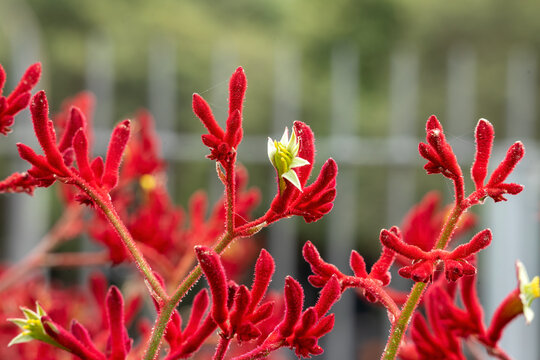
61. Kalmia (Kalmia latifolia)
- Description: Evergreen shrub with clusters of delicate pink or white cup-shaped flowers.
- Features: Prefers acidic soil and partial shade.
- Uses: Ornamental gardens and woodland settings.
- Aesthetic Value: Provides year-round greenery with seasonal floral bursts.
- Ecological Role: Supports bees and other pollinators.
- Cultural Significance: Represents ambition and perseverance.

62. King Protea (Protea cynaroides)
- Description: The King Protea is one of the most iconic and largest flowers in the Protea family. Known for its dramatic appearance, the flower features a large, dome-shaped bloom with a mix of soft pink, red, and white petals. These petals are actually bracts, modified leaves that surround the actual flowers, which are small and tubular in shape. The plant is native to South Africa, specifically the Cape region, and thrives in warm climates.
- Growing Conditions: King Proteas require well-draining, acidic soil and plenty of sunlight. They are drought-tolerant and do not thrive in overly wet conditions. They are best grown in regions with mild winters and warm summers, as they are sensitive to frost.
- Interesting Facts: King Proteas have a unique method of pollination, relying on birds rather than insects. Their flowers are rich in nectar, attracting sunbirds and other pollinators.

Flower names start with “L”
63. Lavender(Lavandula spp.)
- Description: Small, fragrant purple flower spikes with silvery foliage.
- Features: Thrives in sunny, well-drained soil.
- Uses: Aromatherapy, medicinal oils, culinary infusions, and ornamental gardens.
- Aesthetic Value: Adds charm and calming fragrance to any garden.
- Ecological Role: Highly attractive to bees and butterflies.
- Cultural Significance: Symbol of purity, calmness, and devotion; often associated with relaxation.

64. Lily(Lilium spp.)
- Description: Elegant trumpet-shaped flowers available in a rainbow of colors.
- Features: Prefers well-drained soil and sunny spots.
- Uses: Popular in floral arrangements and religious ceremonies.
- Aesthetic Value: Adds sophistication to garden beds and indoor bouquets.
- Ecological Role: Supports pollinators, especially moths.
- Cultural Significance: Represents purity, fertility, and renewal; revered in many traditions.

65. Lilac (Syringa)
- Description: Lilac is a beloved flowering plant known for its sweet fragrance and beautiful clusters of small, tubular flowers. It typically blooms in late spring to early summer and thrives in well-drained soil with full sunlight.
- Color: Lilacs are commonly found in shades of purple, blue, and white, and are often used in gardens to create a romantic atmosphere.
- Aesthetic Value: They are also popular in floral arrangements and symbolize renewal and the first emotions of love.
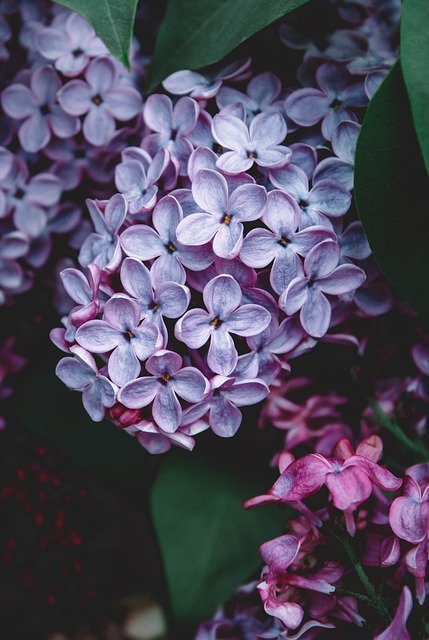
66. Lobelia (Lobelia erinus)
- Description: Lobelia is a trailing or cascading annual plant that produces an abundance of small, bright blue, violet, or white flowers.
- Features: It thrives in full sun to partial shade and prefers moist, well-draining soil.
- Uses: Lobelia is often used as an edging plant in flower beds or in hanging baskets for a vibrant display.
- Aesthetic Value: It is valued for its long blooming period and is ideal for creating eye-catching borders or container gardens.

67. Larkspur (Delphinium ajacis)
- Description: Larkspur is known for its tall, spire-like blooms that come in shades of blue, purple, white, and pink.
- Features: It is an annual or biennial plant that grows best in full sun and well-drained soil.
- Aesthetic Value: Larkspur’s unique, elongated flower spikes make it a favorite for gardens and floral arrangements, symbolizing an open heart and strong bonds. However, they can be toxic if ingested, so caution is needed if pets or children are nearby.

68. Lisianthus (Eustoma grandiflorum)
- Description: Lisianthus is a popular ornamental flower prized for its soft, rose-like blooms.
- Color: It comes in a variety of colors, including white, pink, purple, and blue.
- Features: Lisianthus prefers well-draining soil, full sun, and a warm climate. It has a long vase life, making it a popular choice for bouquets and floral displays.
- Aesthetic Value: Its blooms symbolize appreciation, gratitude, and a sense of elegance.

69. Love-in-a-Mist (Nigella damascena)
- Description: Love-in-a-Mist, also known as Nigella, is an annual plant that grows 45 to 60 cm (18 to 24 inches) tall and features unique, finely divided, lace-like foliage.
- Color: Its flowers are typically blue or white, about 4 cm (1.5 inches) across, and are encased in a protective network of bracts that resemble a mist.
- Features: This flower blooms in spring and early summer and is known for its whimsical, almost fairytale-like appearance. Love-in-a-Mist is self-seeding, making it a low-maintenance option for gardens and can be used to add texture and color to flower beds.

Flower names start with “M”
70. Marigold(Tagetes spp.)
- Description: Cheerful, sun-loving flowers in yellow, orange, and red hues.
- Features: Thrives in warm climates and deters garden pests.
- Uses: Companion planting, decorative garlands, and medicinal applications.
- Aesthetic Value: Vibrant, long-lasting blooms brighten gardens and homes.
- Ecological Role: Attracts beneficial insects like ladybugs.
- Cultural Significance: Sacred in Hindu and Mexican traditions; symbolizes positivity and protection.

71. Magnolia(Magnolia grandiflora)
- Description: Large, fragrant white or pink blossoms with leathery, glossy leaves.
- Features: Thrives in moist, well-drained soil and full sun.
- Uses: Ornamental trees and shrubs for landscaping.
- Aesthetic Value: Adds a majestic, timeless beauty to landscapes.
- Ecological Role: Attracts beetles and supports pollinator populations.
- Cultural Significance: Symbolizes dignity and nobility; celebrated in the American South.

72. Moonflower (Ipomoea alba)
- Appearance: Moonflowers are known for their large, white, funnel-shaped blooms that open at night, releasing a sweet fragrance. The flowers can be up to 6 inches across and are often accompanied by heart-shaped, lush green leaves.
- Bloom Time: They bloom in the evening and remain open until morning, making them an excellent choice for night gardens.
- Growth: This vining plant can grow up to 10–15 feet and thrives in warm climates with full sun exposure.
- Uses: Moonflowers are popular in garden settings for creating a dramatic, nighttime display. They can be grown along fences, trellises, or arbors to provide a stunning visual effect.

73. Morning Glory (Ipomoea tricolor)
- Appearance: Morning glories have vibrant, funnel-shaped flowers that come in a range of colors including blue, purple, pink, and white. The blooms often feature a striking star pattern and can be up to 4–5 inches wide.
- Bloom Time: True to their name, these flowers bloom in the early morning and close by midday, adding a burst of color to the garden at the start of the day.
- Growth: Morning glories are fast-growing climbers that can reach 10–15 feet in length. They do best in full sun and well-draining soil.
- Uses: Commonly used to cover fences, trellises, and arbors, morning glories can create a wall of color and a lush, tropical feel in gardens.
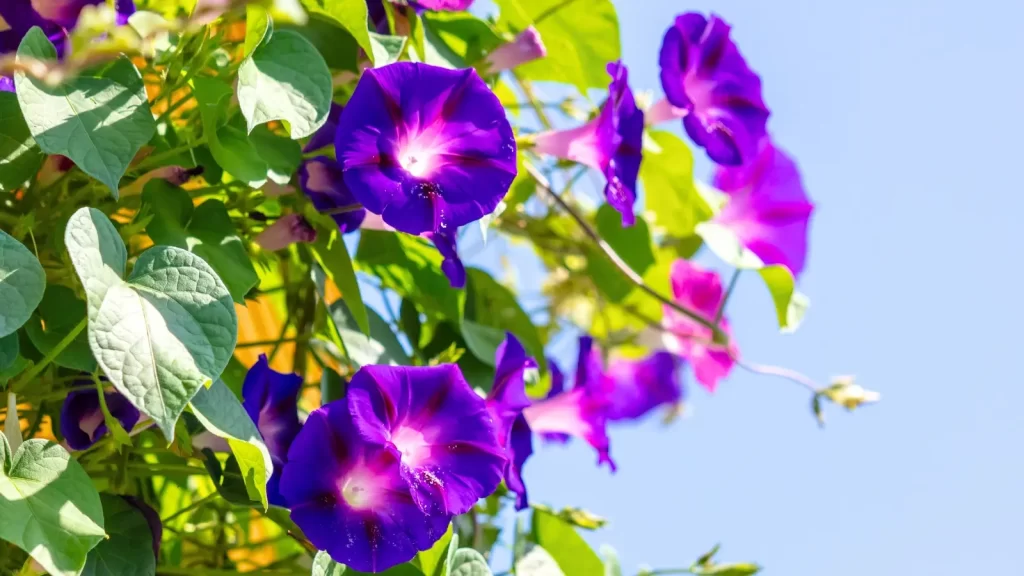
74. Monkshood (Aconitum napellus)
- Appearance: Monkshood is known for its tall, spike-like inflorescence that is topped with hood-shaped, deep blue to purple flowers. The plant’s foliage is deeply lobed and adds an additional texture to garden displays.
- Bloom Time: This plant blooms in late summer to early fall, providing a striking contrast to other flowers in the garden.
- Growth: Monkshood can grow 3–5 feet tall and prefers well-drained soil and partial to full shade. It is native to mountainous areas in Europe and Asia.
- Caution: All parts of the plant are highly toxic if ingested, making it important to plant monkshood out of reach of children and pets.
- Uses: Despite its toxicity, monkshood is appreciated for its dramatic, unique appearance and is often planted for ornamental purposes in gardens with safety considerations.

75. Mexican Sunflower (Tithonia rotundifolia)
- Appearance: Mexican sunflowers are known for their large, bright orange or yellow blooms that resemble sunflowers but with a more vibrant color. The flowers can be up to 4–5 inches across and have a central disc surrounded by petal-like florets.
- Bloom Time: They bloom from mid-summer through fall, attracting pollinators like bees, butterflies, and hummingbirds.
- Growth: This annual plant can grow 4–8 feet tall and is well-suited to full sun and well-draining soil. It can be used as a backdrop in flower beds or as a showy focal point.
- Uses: Mexican sunflowers are great for adding height and vivid color to gardens. They are often used in pollinator gardens to support biodiversity and bring dynamic energy to garden landscapes.

Flower names start with “N”
76. Nasturtium(Tropaeolum majus)
- Description: Brightly colored, edible flowers in shades of red, orange, and yellow.
- Features: Grows as a trailing or bushy plant; thrives in poor soil.
- Uses: Culinary garnishes, companion planting, and ornamental beds.
- Aesthetic Value: Adds a tropical touch to gardens.
- Ecological Role: Attracts aphid predators, helping other plants thrive.
- Cultural Significance: Represents patriotism and resilience.

77. Nicotiana(Nicotiana alata)
- Description: Fragrant, tubular flowers in shades of white, pink, and green.
- Features: Blooms in the evening; thrives in sunny, sheltered spots.
- Uses: Night gardens and pollinator-friendly landscapes.
- Aesthetic Value: Provides elegance with its evening blooms and pleasant scent.
- Ecological Role: Attracts moths and hummingbirds.
- Cultural Significance: Historically used for ceremonial purposes by indigenous peoples.

78. Nerine Lily (Nerine spp.)
- Appearance: Nerine lilies are known for their delicate, tubular, and often trumpet-shaped flowers that come in shades of pink, red, white, and orange. The blooms are usually clustered on a tall, slender stem.
- Bloom Time: They typically bloom in late summer to fall, adding vibrant color to gardens as other plants start to fade.
- Growth: These bulbous plants are compact and grow best in well-draining soil. They can reach heights of up to 18–24 inches and thrive in sunny conditions.
- Uses: Nerine lilies are ideal for garden borders, containers, and as cut flowers due to their striking appearance and long-lasting blooms.
- Care: They require little maintenance, needing occasional watering and well-drained soil to prevent bulb rot.

Flower names start with “O”
79. Orchid(Orchidaceae)
- Description: Exquisite, symmetrical flowers with a wide range of colors and shapes.
- Features: Requires specific conditions, such as well-drained soil and indirect sunlight.
- Uses: Popular in floral arrangements and as decorative houseplants.
- Aesthetic Value: Known for their luxurious and exotic appearance.
- Ecological Role: Essential for pollinators like bees and certain species of moths.
- Cultural Significance: Represents beauty, strength, and refinement; revered in Asia.

80. Osteospermum(Osteospermum spp.)
- Description: Also known as African daisies, these have daisy-like petals in white, purple, and pink.
- Features: Thrives in full sun and well-drained soil.
- Uses: Garden borders, containers, and landscapes.
- Aesthetic Value: Adds bright, cheerful colors to gardens.
- Ecological Role: Attracts bees and butterflies.
- Cultural Significance: Symbolizes peace and positivity.

81. Oleander (Nerium oleander)
- Appearance: Oleander is an evergreen shrub or small tree that boasts showy, funnel-shaped flowers in shades of pink, white, and red. Its long, narrow leaves are a rich, glossy green.
- Growth: Oleander can grow up to 10–20 feet tall, with a dense, rounded shape. It thrives in warm climates, preferring full sun and well-drained soil.
- Caution: Oleander is highly toxic to humans and animals if ingested, with all parts of the plant containing a poisonous milky sap. Care should be taken to plant it out of reach of pets and children.
- Uses: Despite its toxicity, oleander is a popular ornamental plant for hedges and screens due to its lush foliage and vibrant flowers.
- Care: It’s relatively low-maintenance and drought-tolerant, requiring minimal watering once established.

Flower names start with “P”
82. Peony(Paeonia spp.)
- Description: Large, ruffled flowers that come in white, pink, red, and yellow.
- Features: Prefers full sun and well-drained soil, with a long blooming season.
- Uses: Wedding bouquets, ornamental gardens, and floral arrangements.
- Aesthetic Value: Known for lush, fragrant blooms and a sense of luxury.
- Ecological Role: Attracts ants and pollinators, contributing to ecosystem health.
- Cultural Significance: In Chinese culture, peonies symbolize wealth, good fortune, and high status.

83. Pansy(Viola tricolor var. hortensis)
- Description: Compact flowers with unique “face-like” patterns in a variety of colors.
- Features: Hardy, adaptable, and thrives in both sun and partial shade.
- Uses: Winter and early spring gardens, pots, and containers.
- Aesthetic Value: Brightens up garden spaces with its multi-colored blossoms.
- Ecological Role: Attracts bees and small pollinators.
- Cultural Significance: Symbolizes thoughtfulness and free spirit.

84. Petunia(Petunia spp.)
- Description: Bell-shaped flowers with vibrant colors that range from pink and purple to red and white.
- Features: Requires full sun and well-drained soil; low-maintenance and easy to grow.
- Uses: Hanging baskets, flower beds, and borders.
- Aesthetic Value: Popular for its beautiful, long-lasting blooms.
- Ecological Role: Attracts hummingbirds and beneficial insects.
- Cultural Significance: Associated with resilience and nurturing.
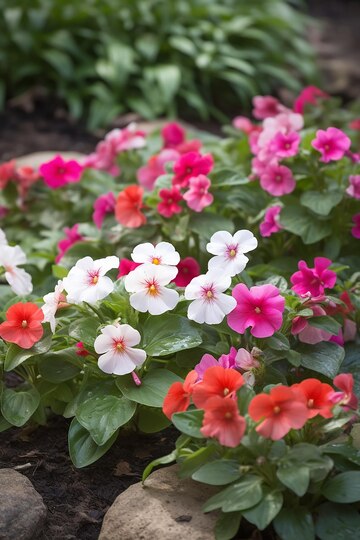
85. Primrose (Primula vulgaris)
- Description: Delicate flowers with pale yellow petals and vibrant centers.
- Feature: Blooms in early spring.
- Uses: Borders, rock gardens, and herbal remedies.
- Aesthetic Value: Adds cheerful color to gardens.
- Ecological Role: Pollinator-friendly, especially for early bees.
- Cultural Significance: Represents youth and renewal.

Flower names start with “Q”
86. Queen Anne’s Lace(Daucus carota)
- Description: Delicate, lacy white flowers that resemble an umbrella.
- Features: Thrives in sunny fields and is often seen as a wildflower.
- Uses: Decorative in wildflower gardens and arrangements.
- Aesthetic Value: Adds a touch of elegance with its airy and refined appearance.
- Ecological Role: Provides nectar for bees and other pollinators.
- Cultural Significance: Often linked to folklore and myths, symbolizing protection and peace.

87. Quince Blossom(Cydonia oblonga)
- Description: Pink to white flowers that bloom before the leaves.
- Features: Prefers sunny environments and well-drained soil.
- Uses: Ornamental tree in gardens and as a fruit-bearing plant.
- Aesthetic Value: Adds a burst of color in early spring.
- Ecological Role: Attracts bees and other pollinators.
- Cultural Significance: Often associated with love and fertility in various cultures.

Flower names start with “R”
88. Rose(Rosa spp.)
- Description: The quintessential symbol of beauty and romance with multi-petaled blooms in nearly every color.
- Features: Requires full sun and well-drained soil; comes in various forms like bush, climbing, and ground cover.
- Uses: Used in bouquets, perfumes, and as ornamental garden plants.
- Aesthetic Value: A symbol of love and elegance.
- Ecological Role: Supports a wide range of pollinators including bees and butterflies.
- Cultural Significance: Symbolizes love, beauty, and passion across different cultures.

89. Ranunculus(Ranunculus spp.)
- Description: Known for its bright, multi-layered petals in various colors.
- Features: Prefers cool weather and well-drained soil.
- Uses: Wedding arrangements and spring gardens.
- Aesthetic Value: Adds texture and brightness with its many-petaled blossoms.
- Ecological Role: Attracts bees and pollinators.
- Cultural Significance: Represents charm and attractiveness.

Flower names start with “S”
90. Sunflower(Helianthus annuus)
- Description: Tall plants with large, bright yellow petals and a dark central disc.
- Features: Follows the sun’s movement (heliotropism) during growth; produces edible seeds.
- Uses: Ornamental gardening, oil extraction, and snacks.
- Aesthetic Value: Represents positivity and joy with its vibrant appearance.
- Ecological Role: Attracts bees and birds; seeds provide food for wildlife.
- Cultural Significance: Symbolizes adoration and longevity in many cultures.

91. Snapdragon(Antirrhinum majus)
- Description: Vibrant, tubular flowers resembling a dragon’s face.
- Features: Thrives in cooler climates and comes in various colors.
- Uses: Adds height to garden beds and is used in bouquets.
- Aesthetic Value: Offers unique charm and texture to landscapes.
- Ecological Role: Attracts pollinators like bees.
- Cultural Significance: Represents grace and strength.

92. Sweet Pea(Lathyrus odoratus)
- Description: Fragrant climbing plants with delicate flowers in pastel shades.
- Features: Best grown with support structures in sunny, well-drained areas.
- Uses: Frequently used in perfumes and cut flower arrangements.
- Aesthetic Value: Provides soft, romantic appeal in gardens.
- Ecological Role: Supports pollination and is nitrogen-fixing for soil improvement.
- Cultural Significance: Symbolizes bliss and gratitude.

93. Star Jasmine (Trachelospermum jasminoides)
- Description: Small, star-shaped, fragrant white flowers.
- Feature: Fast-growing climber.
- Uses: Trellises, walls, and ornamental hedges.
- Aesthetic Value: Creates a fragrant, lush ambiance.
- Ecological Role: Attracts pollinators.
- Cultural Significance: Symbolizes purity and simplicity.

94. Statice (Limonium sinuatum)
- Description: Papery-textured flowers in colors like purple, yellow, and pink.
- Feature: Long-lasting as dried flowers.
- Uses: Floral arrangements and crafts.
- Aesthetic Value: Adds subtle charm.
- Ecological Role: Attracts pollinators.
- Cultural Significance: Symbolizes remembrance.

95. Sweet Alyssum (Lobularia maritima)
- Description: Tiny clusters of white or pastel-colored flowers with a honey-like fragrance.
- Feature: Low-growing and spreading.
- Uses: Ground cover and hanging baskets.
- Aesthetic Value: Softens garden edges.
- Ecological Role: Beneficial for pollinators.
- Cultural Significance: Represents sweetness and beauty.

Flower names start with “T”
96. Tulip(Tulipa spp.)
- Description: Elegant cup-shaped flowers available in almost every color.
- Features: Thrives in well-drained soil and sunny conditions.
- Uses: Used in landscaping, bouquets, and as a cut flower.
- Aesthetic Value: Known for its simplicity and striking hues.
- Ecological Role: Provides nectar for bees in early spring.
- Cultural Significance: Associated with perfect love and royalty.

97. Tiger Lily(Lilium lancifolium)
- Description: Orange flowers with dark spots, resembling a tiger’s coat.
- Features: Perennial plant that thrives in full sun.
- Uses: Ornamental gardens and floral arrangements.
- Aesthetic Value: Adds boldness and drama to flower displays.
- Ecological Role: Attracts butterflies and bees.
- Cultural Significance: Represents pride and prosperity in various traditions.
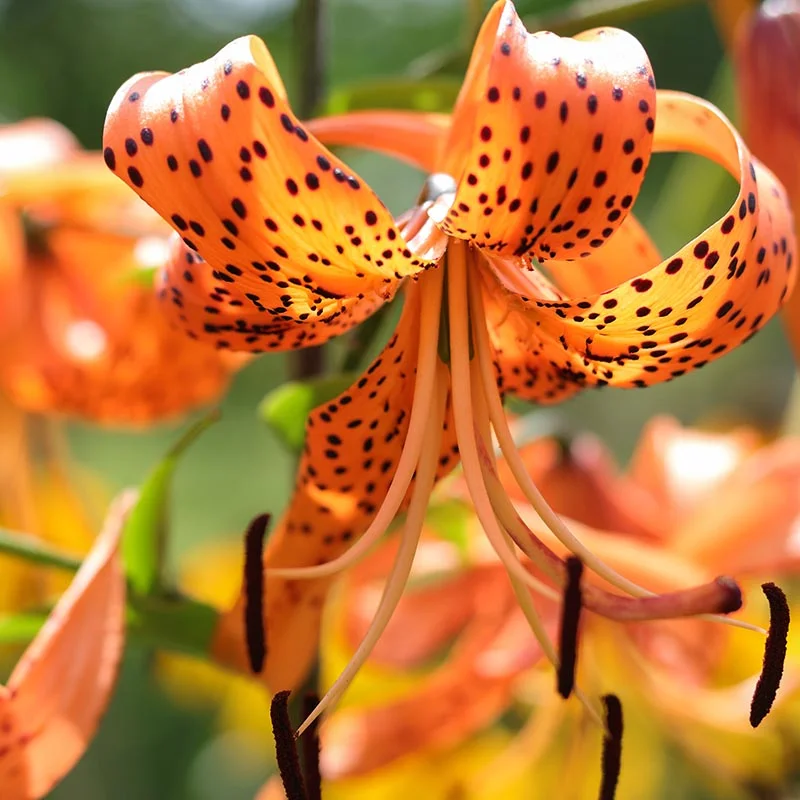
98. Tithonia (Tithonia rotundifolia)
- Description: Bright orange or red daisy-like flowers.
- Feature: Thrives in hot climates.
- Uses: Borders and wildlife gardens.
- Aesthetic Value: Adds bold color.
- Ecological Role: Supports butterflies and hummingbirds.
- Cultural Significance: Symbolizes joy.

Flower names start with “U”
99. Umbrella Flower(Scaevola spp.)
- Description: Fan-shaped flowers in shades of blue, purple, and white.
- Features: Tolerant to heat and drought, ideal for hanging baskets.
- Uses: Ground cover, container planting, and ornamental use.
- Aesthetic Value: Enhances gardens with its cascading growth.
- Ecological Role: Supports pollinators like bees and butterflies.
- Cultural Significance: A symbol of resilience and grace.

Flower names start with “V”
100. Violet(Viola spp.)
- Description: Small, delicate flowers often found in shades of purple and blue.
- Features: Prefers partial shade and rich, moist soil.
- Uses: Edible garnish, perfumes, and ornamental gardens.
- Aesthetic Value: Adds a touch of elegance to shaded garden areas.
- Ecological Role: Attracts bees and butterflies.
- Cultural Significance: Represents modesty and faithfulness.

101. Verbena (Verbena officinalis)
- Description: Clusters of small flowers in shades of purple, pink, or white.
- Feature: Blooms from summer to frost.
- Uses: Bedding plants and hanging baskets.
- Aesthetic Value: Provides continuous color.
- Ecological Role: Attracts pollinators.
- Cultural Significance: Represents healing and creativity.

Flower names start with “W”
102. Water Lily(Nymphaea spp.)
- Description: Aquatic flowers with round floating leaves and vibrant blooms in pink, white, or yellow.
- Features: Found in ponds or slow-moving water; thrives in tropical and temperate climates.
- Uses: Ornamentation in water gardens and natural water filtration.
- Aesthetic Value: Adds serene beauty to aquatic landscapes.
- Ecological Role: Provides shelter and oxygen for aquatic life.
- Cultural Significance: Represents rebirth and purity in various cultures.

103. Wisteria(Wisteria sinensis)
- Description: Cascading clusters of lilac or white flowers on woody vines.
- Features: Deciduous climber requiring support; fragrant blooms in spring.
- Uses: Garden trellises, pergolas, and ornamental walls.
- Aesthetic Value: Romantic and dramatic addition to gardens.
- Ecological Role: Supports pollinators like bees and butterflies.
- Cultural Significance: Symbolizes love, creativity, and longevity.

Flower names start with “X”
104. Xeranthemum(Xeranthemum annuum)
- Description: Drought-tolerant flowers with papery blooms in pink, white, or purple.
- Features: Thrives in dry and sunny areas; long-lasting as dried flowers.
- Uses: Floristry for dried arrangements and xeriscaping.
- Aesthetic Value: Adds charm with its everlasting appearance.
- Ecological Role: Attracts pollinators and survives in arid conditions.
- Cultural Significance: Represents immortality and eternity.
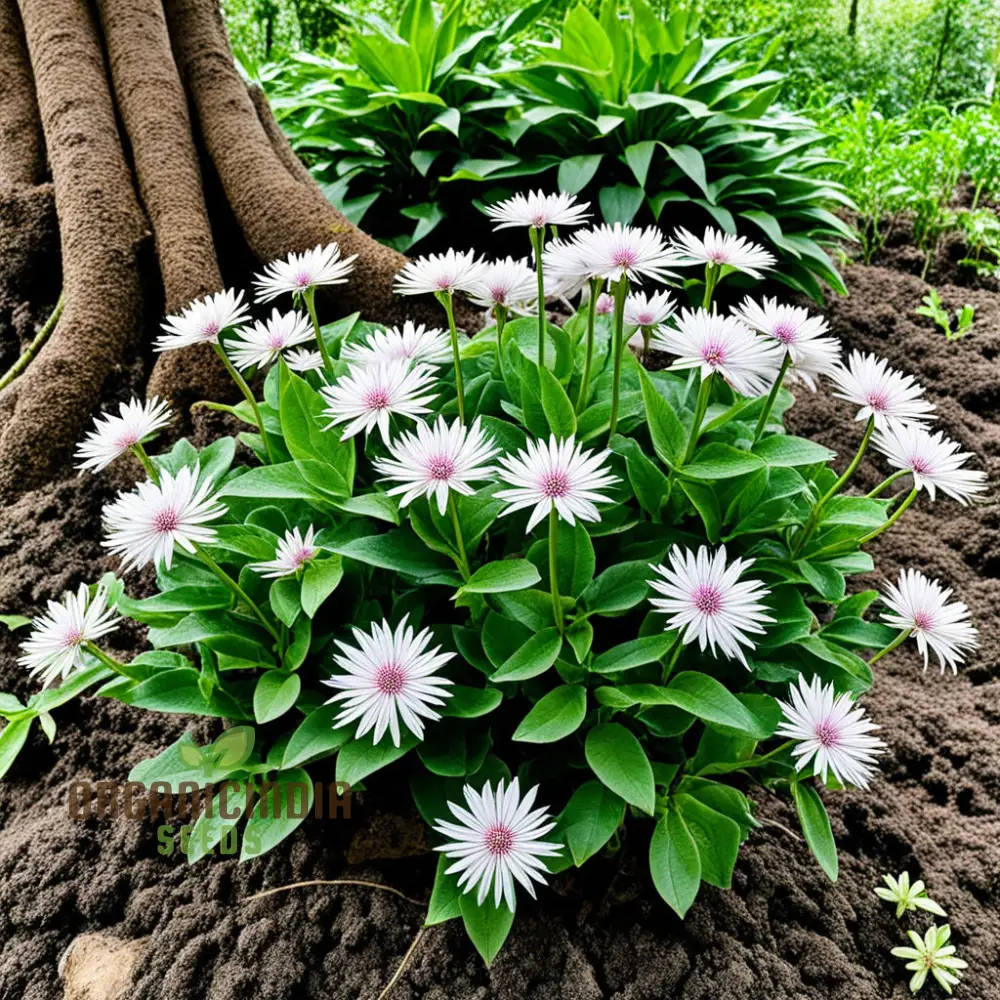
Flower names start with “Y”
105. Yellow Bell(Tecoma stans)
- Description: Bright yellow trumpet-shaped flowers on a bushy plant.
- Features: Heat-tolerant and thrives in arid climates.
- Uses: Ornamental hedges and erosion control.
- Aesthetic Value: Adds vibrant color to desert and tropical landscapes.
- Ecological Role: Attracts pollinators, especially hummingbirds.
- Cultural Significance: Symbolizes cheerfulness and sunshine.

106. Yarrow(Achillea millefolium)
- Description: Tiny flowers forming flat clusters, available in white, yellow, or pink.
- Features: Hardy perennial known for medicinal properties.
- Uses: Herbal remedies, natural landscaping, and erosion control.
- Aesthetic Value: Adds texture and color to wildflower gardens.
- Ecological Role: Attracts beneficial insects like ladybugs.
- Cultural Significance: Associated with healing and protection.
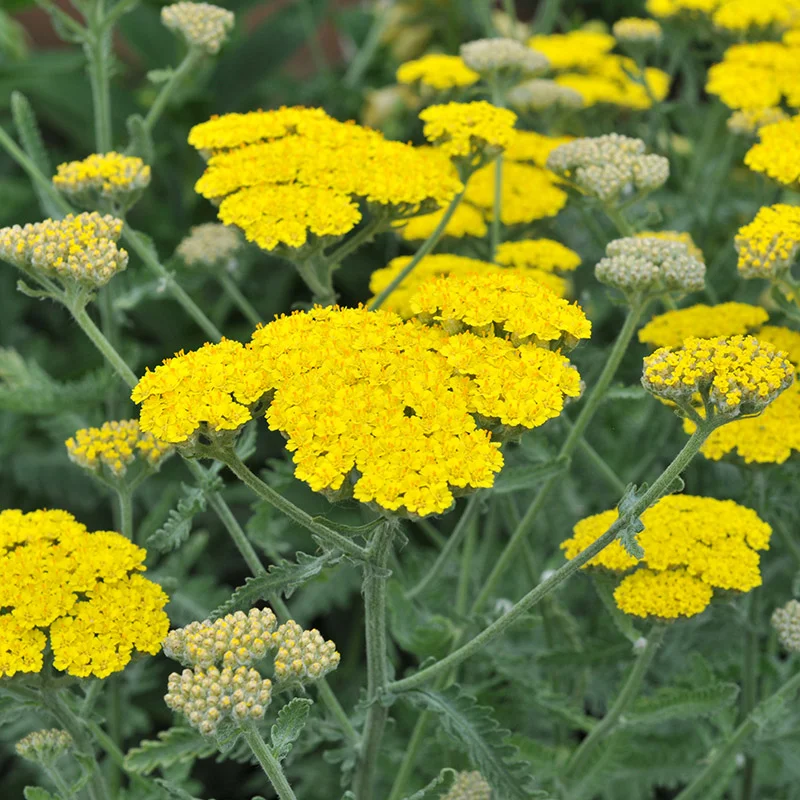
Flower names start with “Z”
107. Zinnia(Zinnia elegans)
- Description: Vibrant, daisy-like flowers in a spectrum of colors.
- Features: Easy-to-grow annual that thrives in sunny spots.
- Uses: Bedding plants, bouquets, and pollinator gardens.
- Aesthetic Value: Adds bold, cheerful hues to any garden.
- Ecological Role: Attracts bees, butterflies, and hummingbirds.
- Cultural Significance: Symbolizes endurance and lasting friendship.

That’s it
Flowers are more than just ornamental additions to gardens or bouquets; they are a testament to the intricate beauty and diversity of the natural world. From the delicate charm of the Cherry Blossom to the resilience of the Yarrow, each flower tells a story, embodies a purpose, and brings color to our lives in myriad ways.
Their ecological importance, such as supporting pollinators and stabilizing ecosystems, coupled with their cultural and medicinal values, underscores the profound connection between humans and flora. By learning about these flowers, we not only appreciate their beauty but also deepen our understanding of nature’s intricate design.
Whether you seek inspiration, knowledge, or simply the joy of discovery, this guide celebrates the enduring allure of flowers—timeless symbols of life, love, and resilience. Explore, admire, and share the magic of these blossoms with the world.








